In a previous post, we explored the first part of a photo album that chronicled a woman’s journey to and from the Alaska-Yukon-Pacific Exposition in 1909.
Our traveler, who remains unidentified, then returned to her life in pre-war New York, where she worked at the Brooklyn Public Library from at least 1910 to 1918, presumably as a librarian.
This post explores the rest of the photos, so we can learn a little more about who she was, and see a few of the scenes and people that she recorded with her camera and memorialized in this small album.
After the last photo taken on the trip back from the Exposition, the album begins afresh on a new page, where she has labeled the next sequence of photos “B.P.L. Brownsville Branch / Nov. 1910 – Oct. 1913.” B.P.L. apparently stands for Brooklyn Public Library, whose name we can see on the front of the building pictured on the first photo. In front of the entry, we see a group of children gathered on the steps.
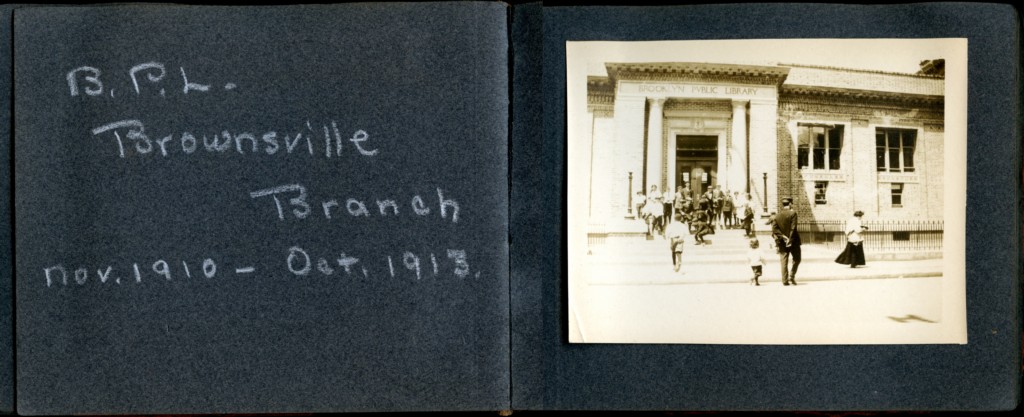
This is followed by several images of more children, who seem to be on a class trip to the library. In the photo below, they seem to be aware of the camera — but the others appear to be candid shots.
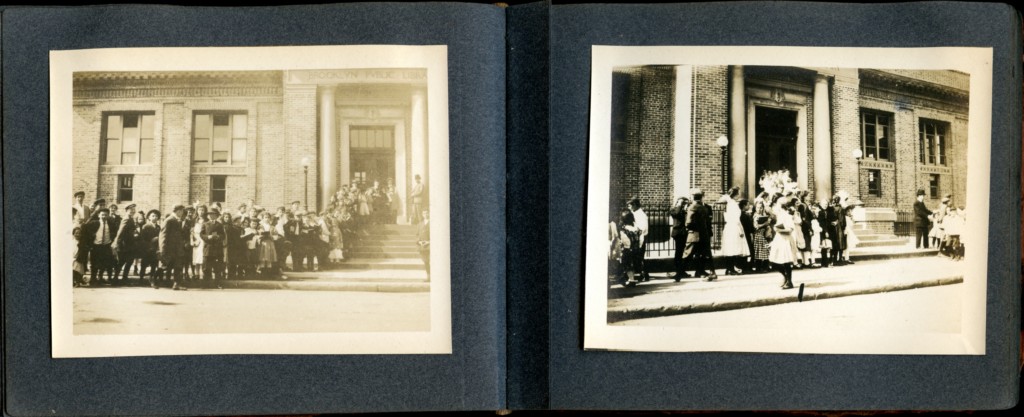
Below we see a studious boy reading intently, from two different angles. The photographer certainly took a lot of pictures of these scenes. Perhaps school visits to the library were such a regular and enjoyable thing that she chose to commemorate one of them as an example of what working at the library was like.
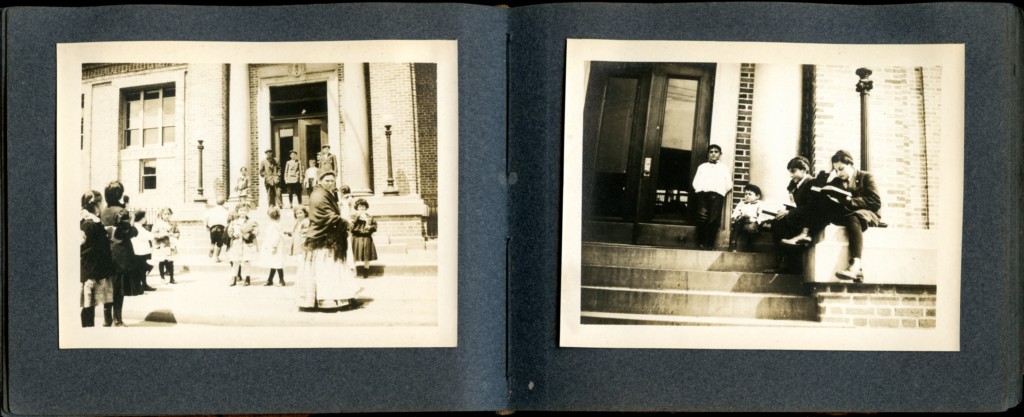
In the photo at right below, we seem to have shifted scenes. Behind the grinning boy in the foreground, we see a number of American flags and some other paraphernalia that I suppose might be associated with a parade or similar event. Also, we don’t seem to be in front of the library anymore.
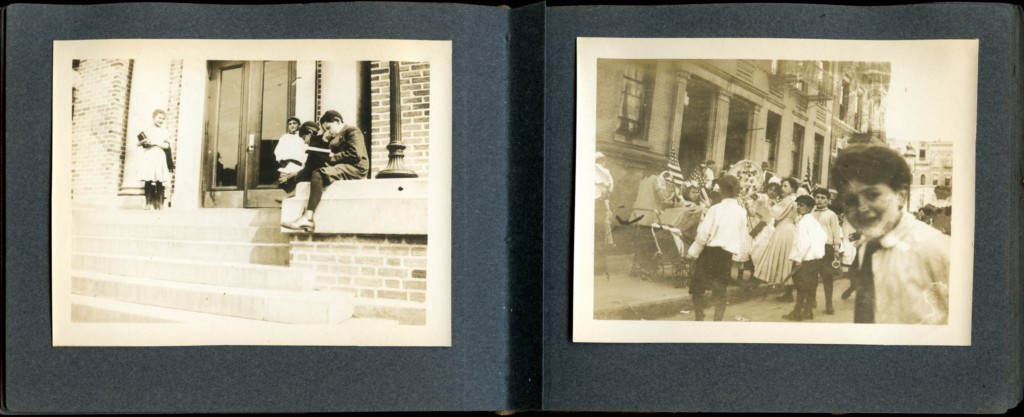
But we’re definitely in Brownsville. The photographer seems to have moved to a public market, and labels these as “Typical scenes in Brownsville.” Here we see a man in a derby hat offering candles for sale. In the full resolution photo, I can see “Monarch Candles” printed on the end of the box at his feet, and there are candles in his hand. In the next photo, it seems that same man is attending to a group of ladies who are inspecting the wares he has arranged on a makeshift table. Again, this seems to be a table full of candles, but even the original photo makes it hard to tell for sure.
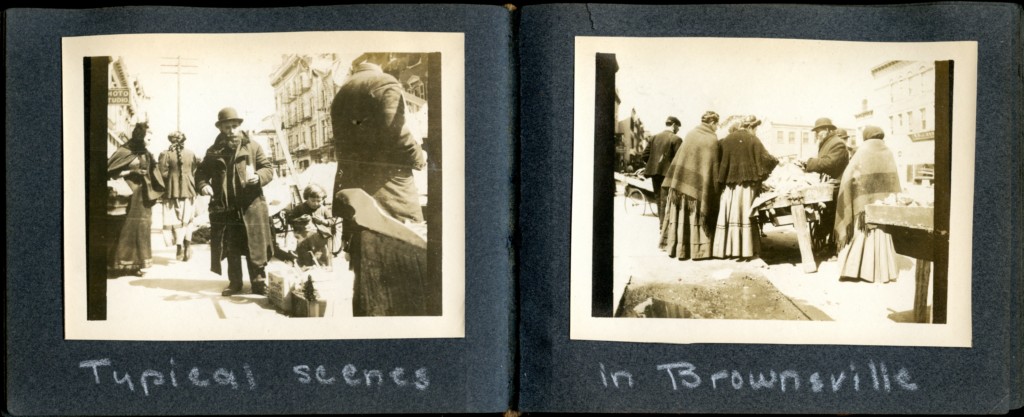
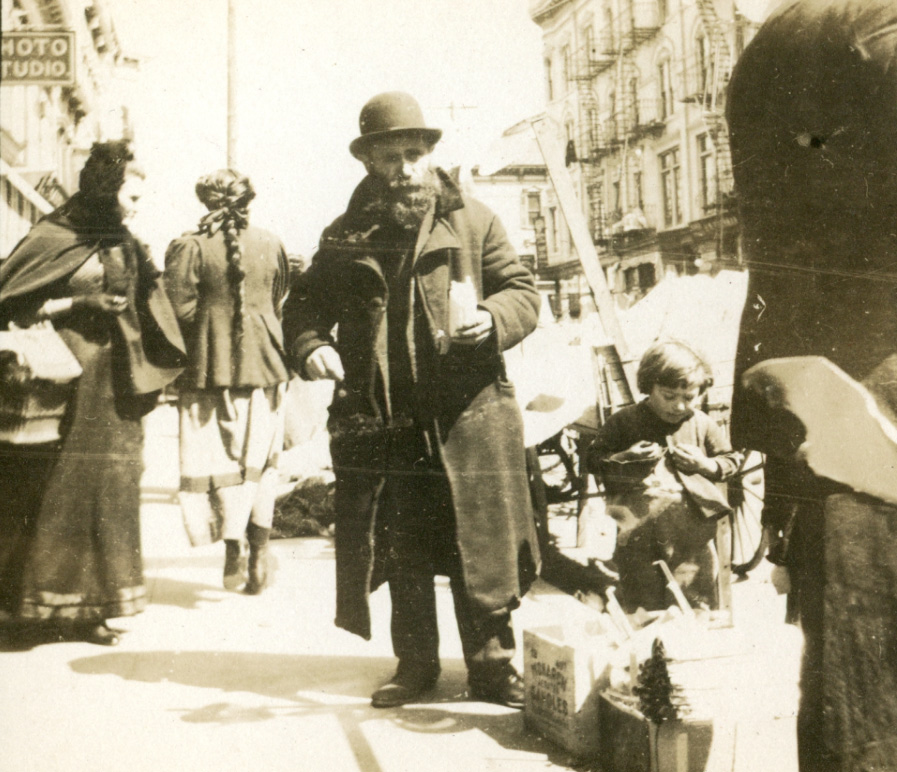
Below, two more scenes at the market. In the photo at right, we can see a large umbrella in the center of the frame. Looking closely, we can tell that something is printed on the umbrella. What is it? We can make out just enough of it to determine that it’s a marketing slogan: “All cars transfer to Bloomingdale’s” — a reference to the department store Bloomingdale’s, which was using that slogan at the time. Perhaps it’s a promotional umbrella that a shopper is carrying?
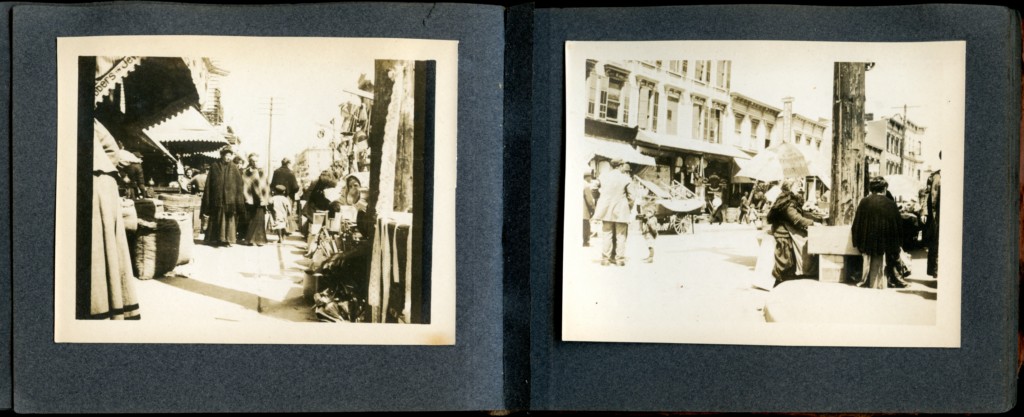
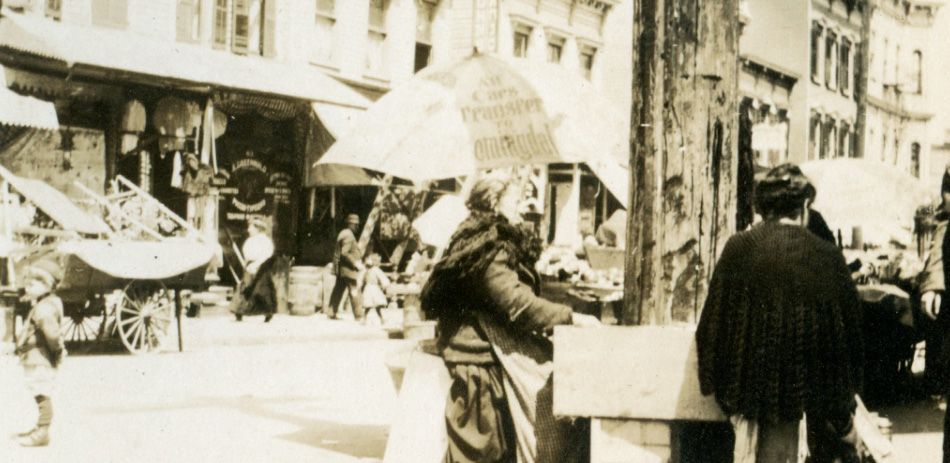
This is followed by a few more typical scenes, which depict the market scene from a farther perspective. If the two scenes below are in sequence, then she is walking in the direction the camera is facing, as we can see the same buildings in the second photo, but closer. So far, nothing particularly interesting or historic — these just seem to be meant to capture some of the typical scenes that she knew well, and wanted to commemorate. In the second photo, the three figures at right are definitely looking at the camera. The rightmost one, standing on the curb, is a teenager or child who is wearing roller skates.
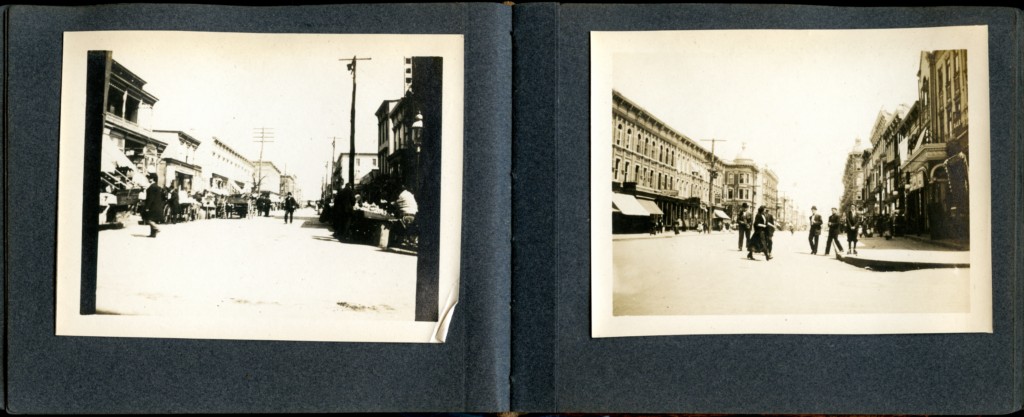
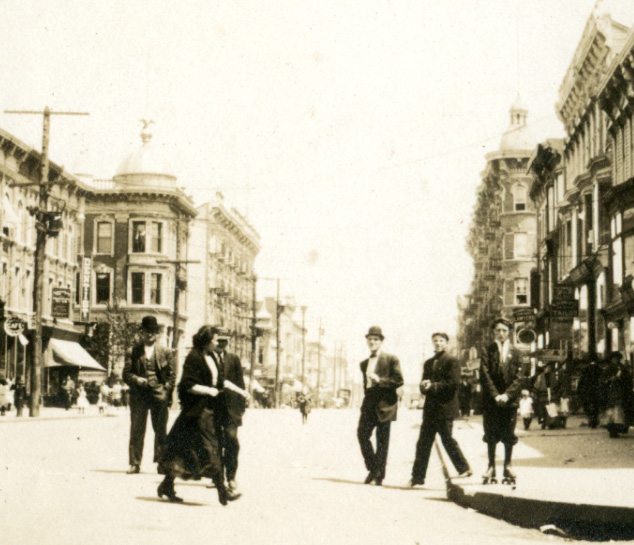
The format of the photo on the left, below, is the same as the photos preceding it, so I suppose it’s part of the same sequence. This one is a bit different because it seems to have a person as the subject. But she isn’t named.
The second photo below is of a different size, so it’s not from the same roll of film. It shows two women, named Lucille Johnston and H. R. Bull. Perhaps these were two of her coworkers at the Brownsville branch.
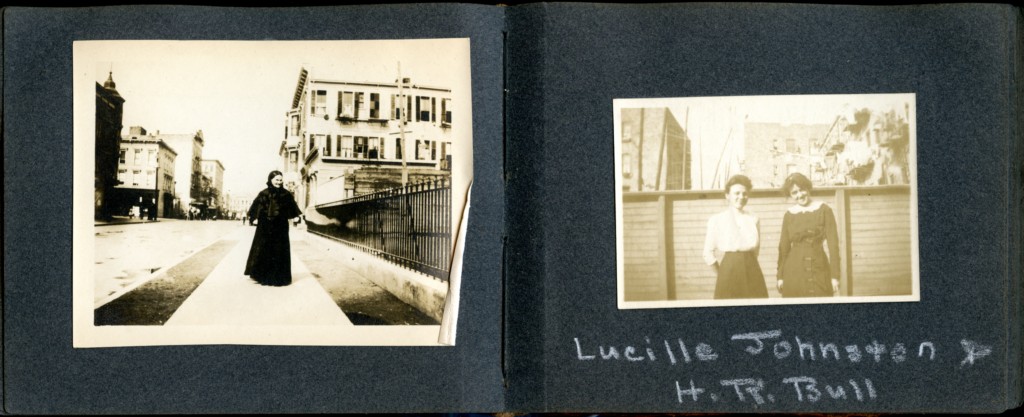
Now we begin the next sequence, which is labeled “B.P.L. Prospect Branch Oct. 1913-Sept. 1917.” The Prospect Branch of the Brooklyn Public Library is now known as the Park Slope Branch.
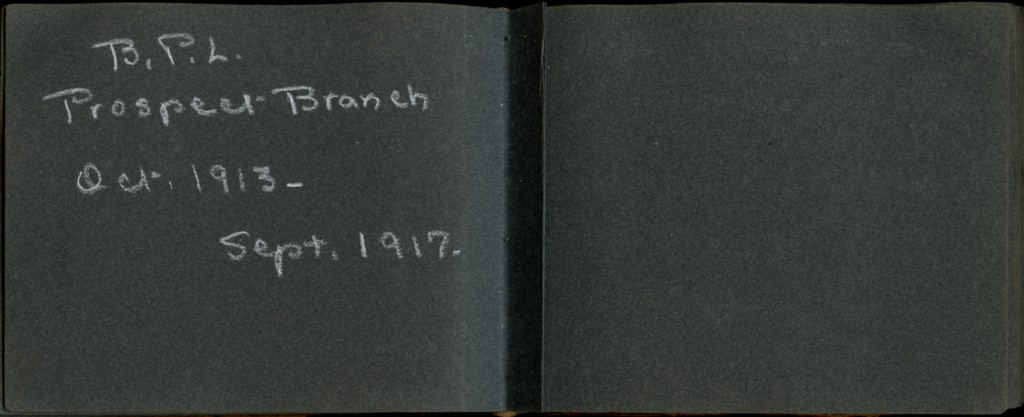
The Prospect Branch was a Carnegie library, built not too many years before. So it’s a bit surprising that it’s being remodeled in these photos. The photographer has taken a lot of interest in this project, and it must have been very disruptive for her.
It’s interesting that she has titled the sequence as being from 1913 to 1917, yet the first photo is dated 1917 – so the dates seem to refer to her time at this branch, not so much the dates of the photos. We might surmise that she was four years into it when the place was remodeled, and that was the first occasion that was noteworthy enough to photograph.
The first is of the Adult Reading Room under renovation in 1917. On the back of the photo, she has written, “Taken from top of reading room desk.” The next photo is also labeled on the back, “Adult Reading Room from top of 600’s case.” It seems she wanted to capture the disruption enough that she climbed on top of a desk and bookcase to do so.
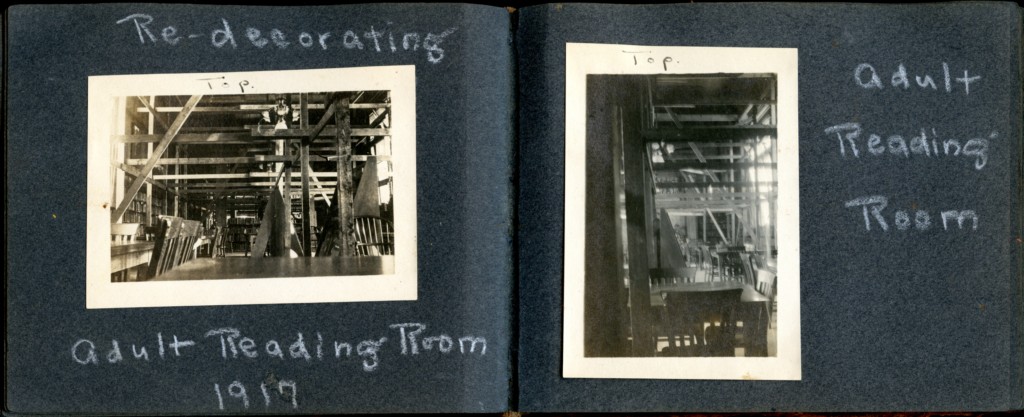
The next picture is of the skeleton of the “Loan desk and Childrens Room.” On the back it says, “taken from top of 600’s case”. So this scene must also have been visible from the 600’s case, possibly because the walls were no longer there. In the second photo below, on the back it says, “This has no name. The electric fan appears to have gotten into it but I know [it] didn’t. It does show the upper rafters.” She’s probably referring to the ghostly white images that appear in the lower part of the frame. It looks to me like an unintentional double exposure, which often happened with these old cameras, when advancing the film was done manually by turning a knob. She probably flipped the shutter unknowingly at some point when handling the camera.
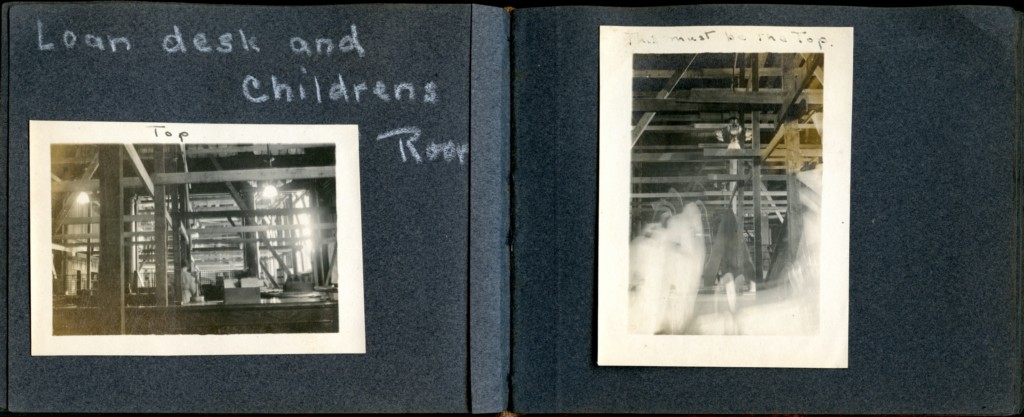
Below we see a tidy picture of the front of the Prospect Branch. On Wikipedia today, there is a picture that looks like it was taken from exactly this spot. It’s refreshing to see a city scene with no cars. In fact, there are no cars in any of these photos, even though there must have been a lot of them around by 1917. It might be because the exterior scenes are in a public market, where cars didn’t go. Still, we don’t see them in the wider street scenes. Maybe she wasn’t fond of them.
The next frame begins a sequence of three photos of a group of five women. In the first, they are labeled as: J. Nevin, H. Wheeler, J. Powers, G. Mast, and L. Tuomi. Again I would speculate that these were some of her coworkers at the Prospect Branch in 1917. Unfortunately, their names are common enough that they are hard to research, especially since the first names are only abbreviated.
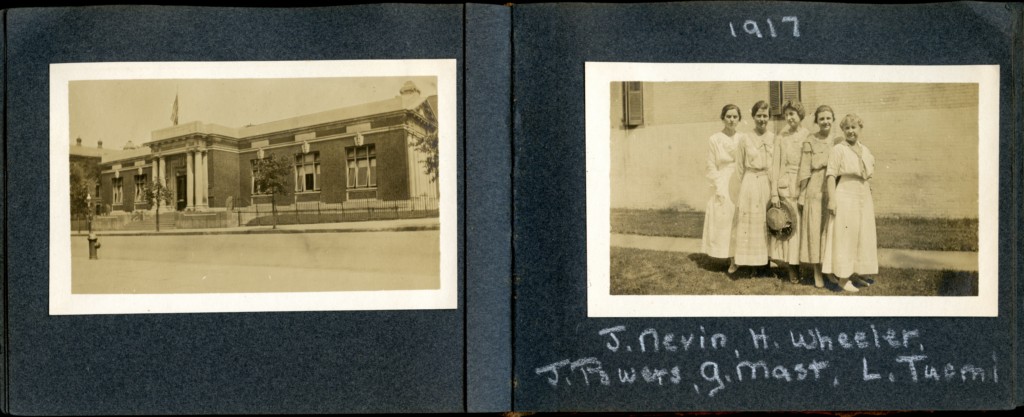
Below we can tell these are largely the same women, in different arrangements. There is the woman with the checkered skirt, the woman holding the hat, and the shorter woman who appears older than the rest. However, in the photo at left below, the older woman has stepped out of the scene and another woman has appeared, at the very left. It seems fair to speculate that the older woman has gone behind the camera, so that the new woman can appear in the picture. So, this might be a hint: if the woman at left, in the left photo below, was the photographer of the other two photos, is she also the owner of the album?
The tall girl in the checkered skirt has also appeared in this photo, at the right of the group. However, she’s also in the next one, where the woman at left has presumably returned to the camera. And we do see the woman at left in later pictures.
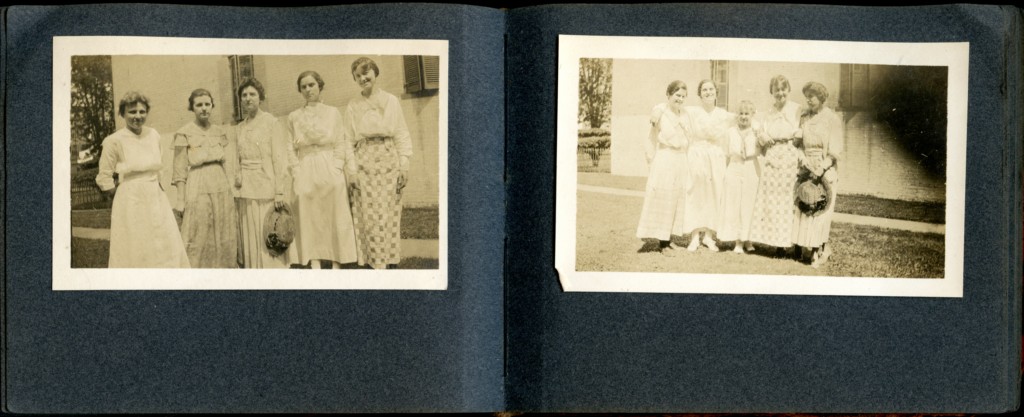
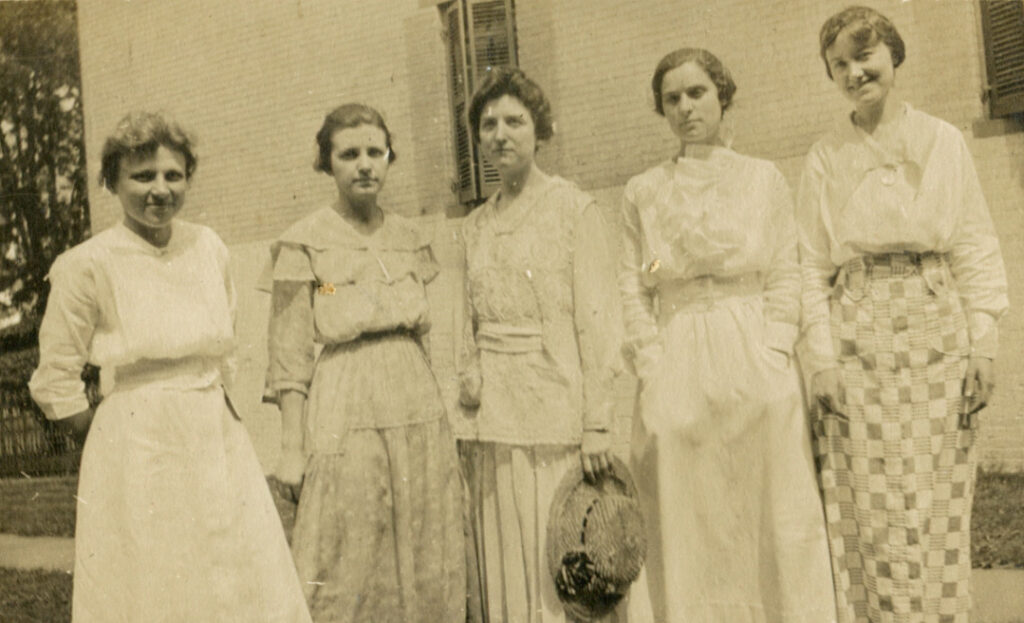
In the next photo below, which seems to be from a different roll of film, here is the mysterious woman again, near the center of the frame. The photo is uncaptioned, as if the identity of the persons was obvious. Maybe this is our photographer again?
At lower right, we have a view inside the Prospect Staff Room. Peeking at the back of the photo, someone has written: Staff Room at P where we spent many a “jolly mealtime” (her quotes).
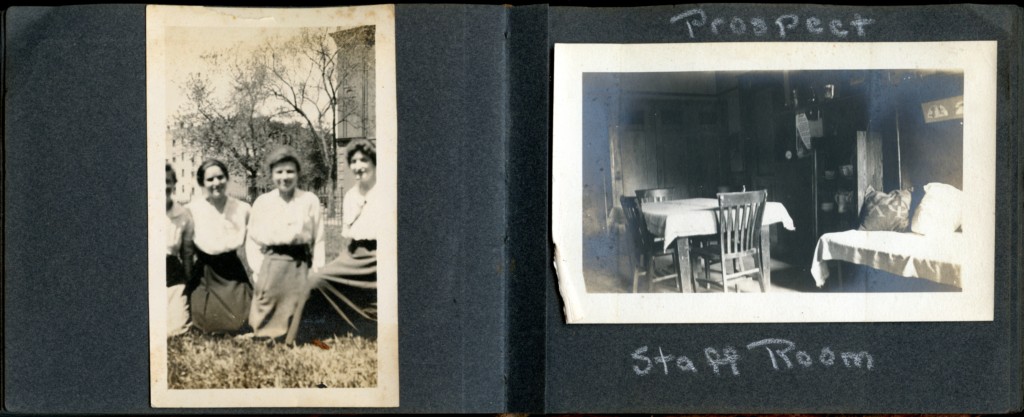
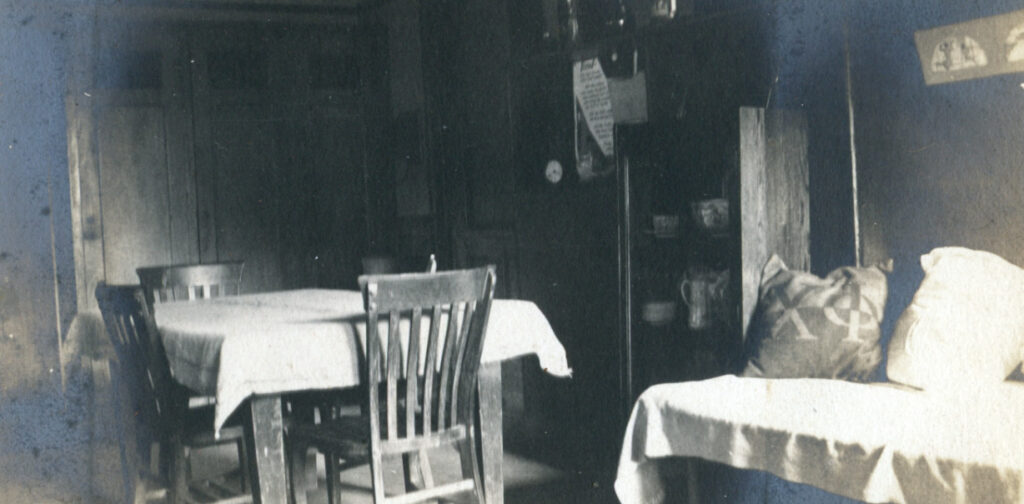
The next photo is particularly intriguing. It has good clarity and resolution, and the face of the person seated could very well be the person we identified as the possible photographer above. It also has an inscription on the back: “Upper Reference Room where the ‘700’ are now placed / Taken the week of my resignation / Oct. 5 / [year obscured]. This strongly suggests that it’s a photo of the album owner. This and the next photo are both captioned with a mysterious abbreviation, “I. L. M. T.” Could this be her initials?
In the rightmost photo, she is no longer in an urban setting, but instead in a lush country setting perhaps, posing with two children identified as Katherine and Lester. It is still 1917.
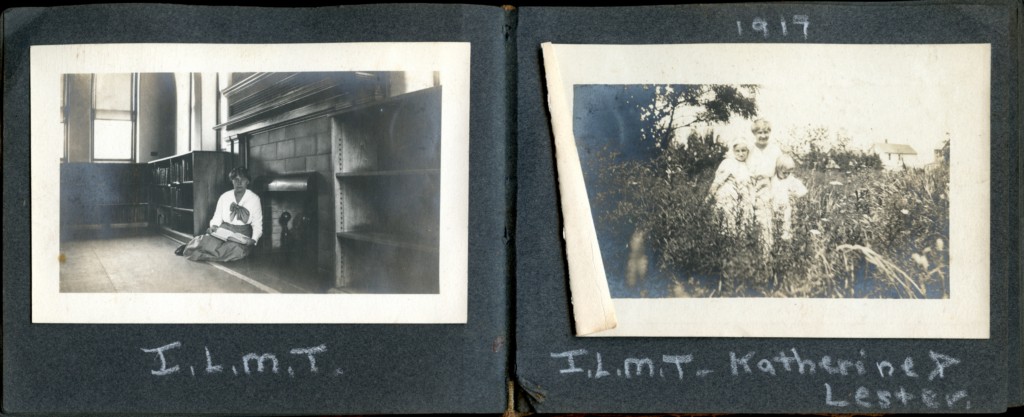
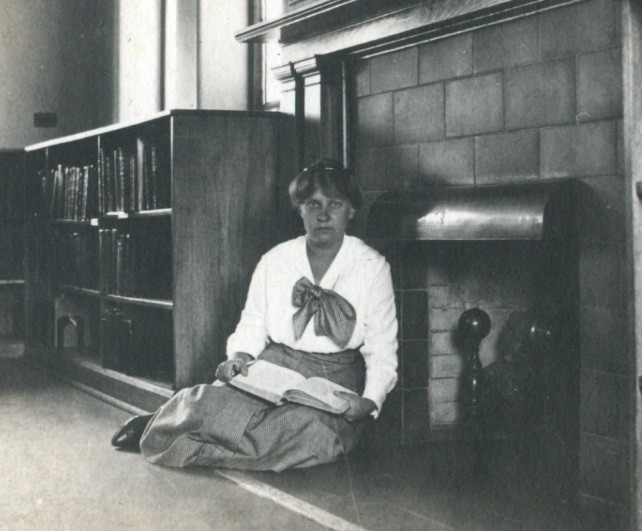
This sequence ends with another picture of two people, labeled “Albany, July 9, 1917.”
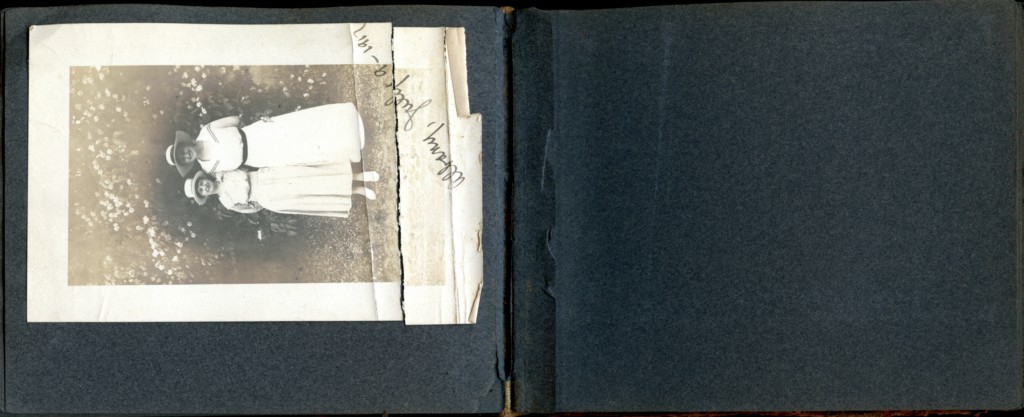
She might be the person on the left. So, does this mean that she quit her job at the library and moved to Albany?
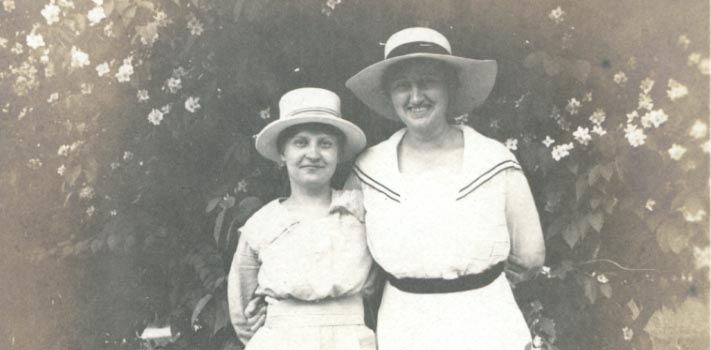
Back to Brooklyn
It seems not! Turning the page, we see that in the same month she resigned, she is back in Brooklyn snapping pictures, this time at the Borough Park Branch, for at least a year. So, her “resignation” might simply have been to join the Borough Park Branch.
At lower right we see two women, named Sophrona A. Weeks and Amelia Bovino. Based on the order of the names, it’s tempting to think Sophrona is on the left, but actually a later photo shows that it’s Amelia. So this casts into doubt that we can rely on her ordering of names to match the images in any of her photos. She likely knew the people so the ordering didn’t matter to her.
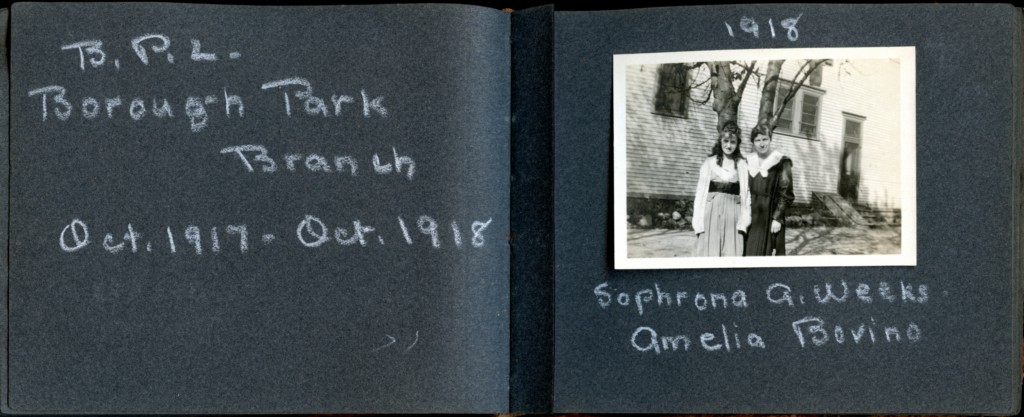
The names Sophrona Weeks and Amelia Bovino are unusual enough that it’s possible to find some information on them. A search for “Sophrona A. Weeks Brooklyn” leads to a mention in a New York Libraries quarterly report from 1916, where she is listed as an assistant librarian at Chatham Public. I also had some success at finding an Amelia Bovino in the Proceedings of the Board of Aldermen for 1920, where she was listed as Junior Clerk, Grade 1 at an annual salary of $540. In the same book we see that Sophrona would make $900 in 1920, as Junior Library Assistant, Grade 1.
In the photos below, “S.A.W.” must stand for Sophrona A. Weeks. She must have wanted a couple more pictures taken.
If we assume that these pictures were taken at work, then this could be the back yard of the library building, but we can’t really know very easily.
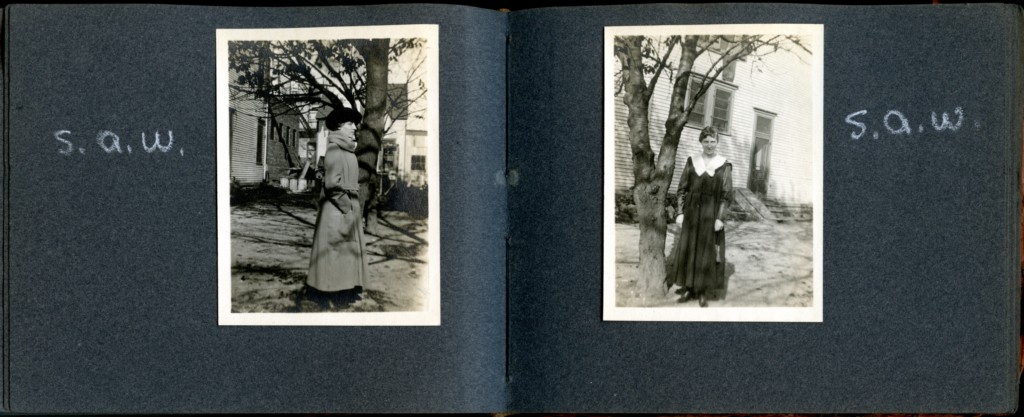
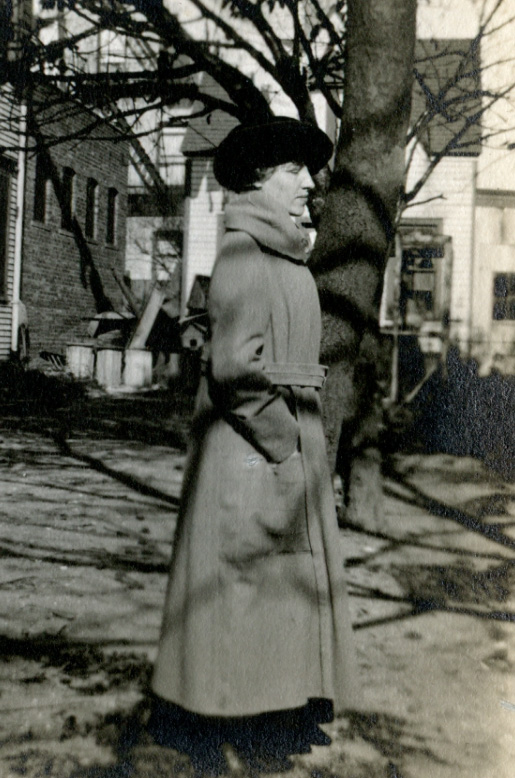
It isn’t just Sophrona; her colleagues aren’t camera shy either. Now others are getting into the act: here we see Louise H. Foster and Margot Meinke. Margot was also Junior Library Assistant Grade 1 by 1920, and is listed with Sophrona in the Aldermen report at $900 salary. Louise Foster is listed in the same position, but at only $840.
In this picture, it is 1918, and Margot has another 70 years ahead of her. She was a young German immigrant of about 22, having arrived as a child in 1904 and remaining in Brooklyn for her whole life, where she died in 1988.
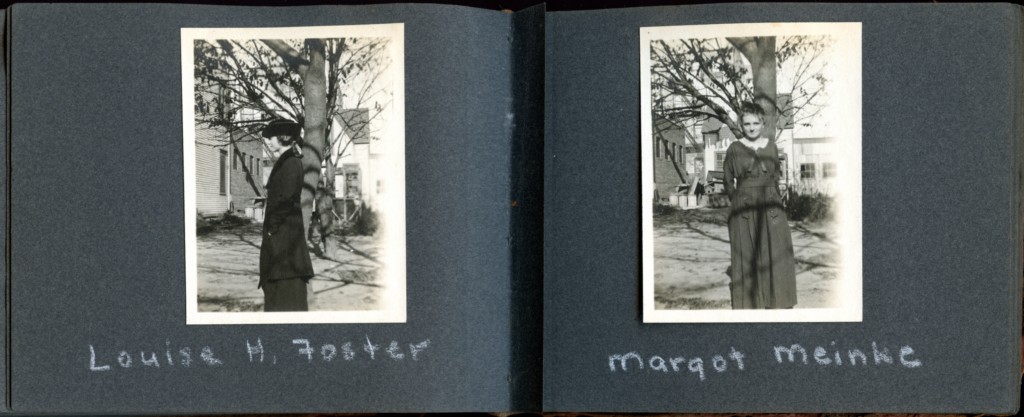
Finally, we come to the last two images of the album. First we see Amelia again, this time captioned only with her first name. Perhaps this suggests a greater friendship or familiarity, or perhaps because she was a youngster (she seems young), or just because her last name was already shown previously.
And finally, we see an uncaptioned photo of the same woman who we are starting to believe must be the photographer. It makes sense that she might finish this book of memories with a photo of herself.
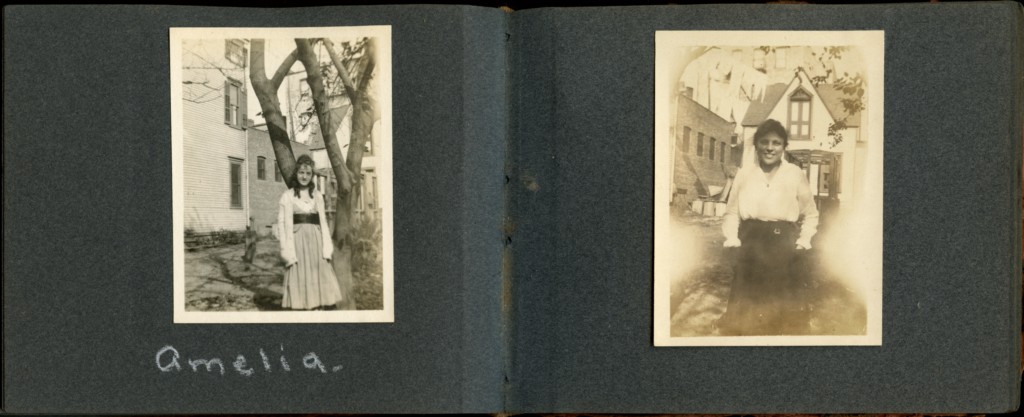
On the back of this final photo, there is a very intriguing caption:
“Please [illegible] the back ground I wish to keep ever before me.”
The illegible word is obscured by the glue that holds the photo in the album. But I think we can read this as evidence that these photos and memories were treasured indeed.
In summation, we still don’t know very much about the woman who owned the album, except to say that she must have been a librarian with the Brooklyn Public Library, in the years before and during the First World War — and the Spanish Flu pandemic. Her initials might have been I.L.M.T. She had a camera, liked to travel, and was not ashamed to clamber up on desks and bookcases to take photos of interior construction.
Perhaps, a careful perusal of the Alderman report, or the Quarterly of the New York Public Libraries, might reveal someone with those initials. I’m not likely to go to those lengths. I’m satisfied just knowing a bit about her, and knowing that, if I had had a chance to meet her, I would likely have found her quite intriguing. I hope she would not have minded her photos being aired in this way. Perhaps, now that we see them, some day they will be seen as “historical.”
After this final image, there are many unused pages in this small album. They suggest something unfinished or incomplete. Did she leave her library career soon after, and dedicate this album strictly to memories of that career? The last photo, with its inscription, seems to suggest a certain finality — a closing of a chapter, one to be remembered and preserved — and which no later pictures could rightfully follow. Not in the same album, at least.
Article and scans of images Copyright 2021 by the author.
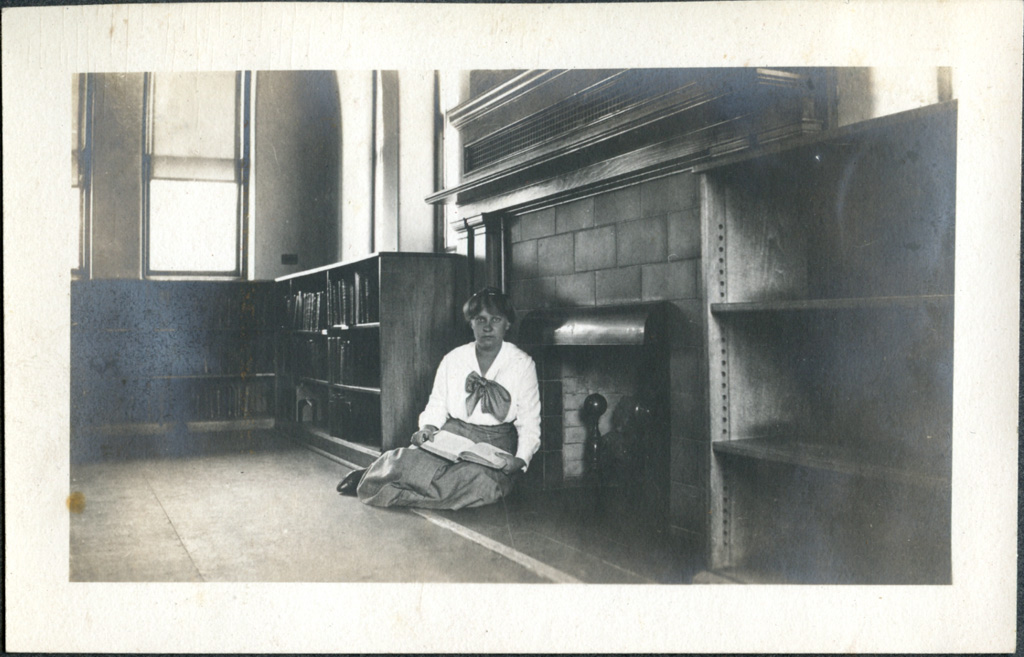


One Comment
Pingback: